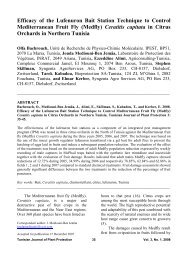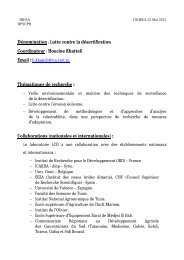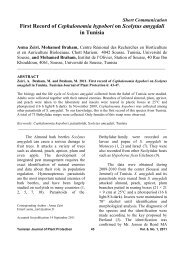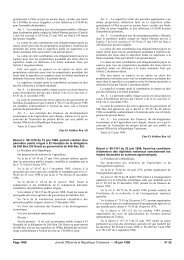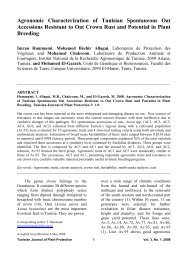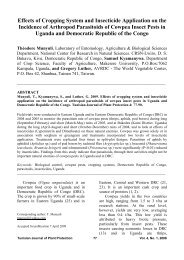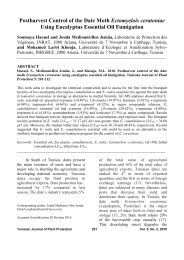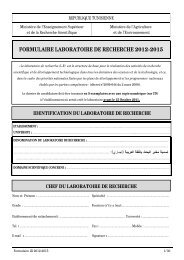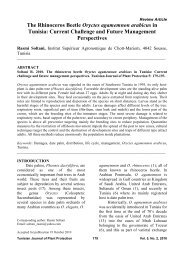E. camaldulensis seems to be moreattacked than the other Eucalyptus species<strong>and</strong> heavy infestations, reaching 100% <strong>of</strong>attacked seedlings, were reported mainlyin young plantations <strong>and</strong> nurseryseedlings <strong>of</strong> this species. Currently, nocontrol measures are available againstboth species, even if the parasitingactivity <strong>of</strong> Closterocerus chamaeleonseems to effectively reduce the infestationlevels <strong>of</strong> O. <strong>maskelli</strong> (7, 25). However,more precautions would be needed whenexchanging eucalyptus plants forplanting, enhancing the level <strong>of</strong>monitoring <strong>and</strong> carrying out research inarboretums to identify Eucalyptus specieswhich resist to this gall wasp.__________________________________________________________________________RESUMEDhahri S., Ben Jamaa M.L. et Lo Verde G. 2010. Première observation de <strong>Leptocybe</strong> <strong>invasa</strong> et<strong>Ophelimus</strong> <strong>maskelli</strong> insectes gallicoles d’eucalyptus en Tunisie. Tunisian Journal <strong>of</strong> PlantProtection 5: 231-236.Deux espèces australiennes d’insectes gallicoles ont été détectées pour la première fois en Tunisie surle feuillage des arbres d’Eucalyptus camaldulensis: <strong>Leptocybe</strong> <strong>invasa</strong> observée en 2004 et <strong>Ophelimus</strong><strong>maskelli</strong> en 2006. L. <strong>invasa</strong> provoque des galles sur les pétioles, la nervure principale de la feuille et lesjeunes pousses t<strong>and</strong>is que O. <strong>maskelli</strong> induit des galles au niveau des limbes. Une vigilance estrecomm<strong>and</strong>ée au niveau du transport des plants d’une région à une autre.Mots clés: Eucalyptus, insectes gallicoles, <strong>Leptocybe</strong> <strong>invasa</strong>, <strong>Ophelimus</strong> <strong>maskelli</strong>, Tunisia__________________________________________________________________________ملخصظاهري، سمير ومحمد لحبيب بن جامع وغابريالا لو فيردي.وأوّل تسجيل لدبوري التدرن<strong>Leptocybe</strong> <strong>invasa</strong>.2010<strong>Ophelimus</strong> على أشجار الأوآالبتوس في تونس.Tunisian Journal <strong>of</strong> Plant Protection 5: 231-236.<strong>maskelli</strong>تمتم لأوّل مرّة في تونس تسجيل دبورين أستراليين على أوراق أشجار الأوآالبتوسفي سنة يسبب انتفاخًا علىفي سنةآشفمستوى العنق والعرق الرئيسي للورقة والأغصان الفتية. أمّا فإنه يحدث انتفاخا على النّصل. يوصى باليقظةالمستمرة وبخاصة أثناء نقل الشتلات الحراجية/الغابية إلى أماآن زراعتها.:Eucalyptus camaldulensisL. <strong>invasa</strong> .20062004 و <strong>Ophelimus</strong> <strong>maskelli</strong>O. <strong>maskelli</strong><strong>Leptocybe</strong> <strong>invasa</strong>آلمات مفتاحية: أوآالبتوس، تونس، دبابير التدرن،<strong>Leptocybe</strong> <strong>invasa</strong> ،<strong>Ophelimus</strong> <strong>maskelli</strong>___________________________________________________________________________LITERATURE CITED1. Arzone, A. <strong>and</strong> Alma, A. 2000. Eul<strong>of</strong>idegalligeno dell’Eucalipto in Italia. Infor. Fitopat.50: 43-46.2. Bella, S. <strong>and</strong> Lo Verde, G., 2002. Presenzanell’Italia Continentale e in Sicilia di <strong>Ophelimus</strong>prope eucalypti (Gahan) e Aprostocetus sp.,galligeni degli Eucalipti (HymenopteraEulophidae). Naturalista Sicil. S. IV 26: 191-197.3. Ben Jamâa, M.L. Villemant, C., et M’nara, S.2002. Phoracantha recurva Newman, 1840(Coleoptera, Cerambycidae): un nouveauravageur des Eucalyptus en Tunisie. Rev. Fr.Entomol. 24: 19-21.4. Billioti, E. et Schoenenberger, A. 1962. Sur laprésence en Tunisie de Phoracantha semipunctataFab. (Coleoptera, Cerambycidae) ravageur del’Eucalyptus. Ann. INRAT 35: 97-109.Tunisian Journal <strong>of</strong> Plant Protection 234 Vol. 5, No. 2, 2010
5. Branco, M., Boavida, C., Dur<strong>and</strong>, N., Franco,J.C., <strong>and</strong> Mendel Z. 2009. Presence <strong>of</strong> theEucalyptus gall wasp <strong>Ophelimus</strong> <strong>maskelli</strong> <strong>and</strong> itsparasitoid Closterocerus chamaeleon in Portugal:<strong>First</strong> record, geographic distribution <strong>and</strong> hostpreference. Phytoparasitica 37: 51-5415. Laudonia, S., Viggiani, G., <strong>and</strong> Sasso, R. 2006.Parassitoide esotico in aiuto degli eucalipti.Inform. Agr. 40: 74.16. Lo Verde, G., Dhahri, S., <strong>and</strong> Ben Jamâa, M.L.2010. <strong>First</strong> record in Tunisia <strong>of</strong> Closteroceruschamaeleon (Girault) parasitoid <strong>of</strong> the Eucalyptus6. Branco, M., Franco, J.C., Valente, C., <strong>and</strong>Gall Wasp <strong>Ophelimus</strong> <strong>maskelli</strong> (Ashmead)Mendel, Z. 2006. Survey <strong>of</strong> Eucalyptus gall wasps(Hymenoptera: Eulophidae) in Portugal. Boletínde Sanidad Vegetal, Plagas 32: 199-202.7. Caleca, V., Rizzo, M.C., Lo Verde, G., Rizzo, R.,Buccellato, V., Luciano, P., Cao, O., Palmeri, V.,Gr<strong>and</strong>e, S.B., <strong>and</strong> Campolo, O. 2009. Diffusionedi Closterocerus chamaeleon (Girault) introdottoin Sicilia, Sardegna e Calabria per il controllobiologico di <strong>Ophelimus</strong> <strong>maskelli</strong> (Ashmead)(Hymenoptera, Eulophidae), galligeno esotico(Hymenoptera Eulophidae). Naturalista sicil., S.IV 34: 207-210.17. Mendel, Z., Protasov, A., Blumberg, D., Br<strong>and</strong>,D., Saphir, N., Madar, Z., <strong>and</strong> La Salle, J. 2007.Release <strong>and</strong> recovery <strong>of</strong> parasitoids <strong>of</strong> theEucalyptus gall wasp <strong>Ophelimus</strong> <strong>maskelli</strong> inIsrael. Phytoparasitica 35: 330-332.18. Mendel, Z., Protasov, A., Fisher, N., <strong>and</strong> LaSalle, J. 2004. Taxonomy <strong>and</strong> biology <strong>of</strong><strong>Leptocybe</strong> <strong>invasa</strong> gen. & sp. n. (Hymenoptera:sugli eucalipti. Atti III Congr. Nazionale diEulophidae), an invasive gall inducer onSelvicoltura, Taormina 16-19 ottobre 2008 Acc.Ital. Sc. Forestali, Taormina - Me- (ITA), Vol. II:638-642.Eucalyptus. Aust. J. Entomol. 43: 51-63.19. Protasov, A., Blumberg, D., Br<strong>and</strong>, D., La Salle,J., <strong>and</strong> Mendel, Z. 2007a. Biological control <strong>of</strong> the8. Direction Générale des Forêts. 2005. Résultats dugall wasp <strong>Ophelimus</strong> <strong>maskelli</strong> (Ashmead):deuxième inventaire forestier et pastoral national,Taxonomy <strong>and</strong> biology <strong>of</strong> the parasitoid speciesMinistère de l’Agriculture, des RessourcesClosterocerus chamaeleon (Girault), withHydrauliques et de la Pêche Tunisie, 129 pp.9. Doganlar, O. 2005. Occurrence <strong>of</strong> <strong>Leptocybe</strong>information on its establishment in Israel.Biological Control 42: 196-206.<strong>invasa</strong> Fisher & La Salle, (Hymenoptera: 20. Protasov, A., Doganlar, M., La Salle, J., <strong>and</strong>Chalcidoidea) on Eucalyptus camaldulensis inTurkey, with a description <strong>of</strong> the male sex. Zool.Middle East 35: 112-114.10. Doganlar, O. <strong>and</strong> Mendel, Z. 2007. <strong>First</strong> record<strong>of</strong> the Eucalyptus gall wasp <strong>Ophelimus</strong> <strong>maskelli</strong><strong>and</strong> its parasitoid, Closterocerus chamaeleon, inTurkey. Phytoparasitica 35: 333-335.11. European <strong>and</strong> Mediterranean Plant ProtectionMendel, Z. 2008. Occurrence <strong>of</strong> two localMegastigmus species parasitic on the Eucalyptusgall wasp <strong>Leptocybe</strong> <strong>invasa</strong> in Israel <strong>and</strong> Turkey.Phytoparasitica 36: 449-459.21. Protasov, A., La Salle, J., Blumberg, D., Br<strong>and</strong>,D., Saphir, N., Assael, F., Fisher, N., <strong>and</strong> Mendel,Z. 2007b. Biology, revised taxonomy <strong>and</strong> impacton host plants <strong>of</strong> <strong>Ophelimus</strong> <strong>maskelli</strong>, an invasiveOrganization. 2006. <strong>First</strong> report <strong>of</strong> two newgall inducer on Eucalyptus spp. in theeucalyptus pests in the south <strong>of</strong> France:Mediterranean Area. Phytoparasitica 35: 50-76.<strong>Ophelimus</strong> <strong>maskelli</strong> <strong>and</strong> <strong>Leptocybe</strong> <strong>invasa</strong>. EPPOReporting Service 9: 9.12. European <strong>and</strong> Mediterranean Plant ProtectionOrganization. 2006. Addition <strong>of</strong> <strong>Leptocybe</strong> <strong>invasa</strong>to the alert list. EPPO Reporting Service 9: 10.22. Pujade-Villar, J. <strong>and</strong> Riba-Flinch, J.M. 2004.Dos especies australianas de eulófidos, muydañinas para Eucalyptus spp., introducidas en elnordeste ibérico (Hymenoptera: Eulophidae).Boln. S.E.A. 35: 299-301.13. Hesami, S., Alemansoor, H., <strong>and</strong> 23. Rizzo, M.C., Lo Verde, G., Rizzo, R.,Seyedebrahimi, S. 2005. Report <strong>of</strong> <strong>Leptocybe</strong>Buccellato, V., <strong>and</strong> Caleca, V. 2006. Introduzione<strong>invasa</strong> (Hym.: Eulophidae), gall wasp <strong>of</strong>di Closterocerus sp. in Sicilia per il controlloEucalyptus camaldulensis with notes on biologybiologico di <strong>Ophelimus</strong> <strong>maskelli</strong> Ashmeadin Shiraz vicinity. J. Entomol. Soc. Iran 24: 99-108.14. Khouja, M.L., Khaldi, A., <strong>and</strong> Rjeb, M.N. 2001.Results <strong>of</strong> the eucalyptus introduction trials inTunisia. Pages 163-168. Proceeding <strong>of</strong> theInternational Conference on Eucalyptus in theMediterranean Basin: Perspectives <strong>and</strong> New(Hymenoptera Eulophidae) galligeno esotico sugliEucalipti. Boll. Zool. Agr. Bachic. 38: 237-248.24. Sánchez, I. 2003. Descubiertas dos nuevasplagas del eucalipto en España. Quercus 214: 32-33.25. Sasso, R., Laudonia, S., <strong>and</strong> Viggiani, G. 2008.Dati preliminari per il controllo biologico diUtilization. October 15-19, 2000, Centro<strong>Ophelimus</strong> <strong>maskelli</strong> (Ashmead) (Hymenoptera:Promozione Pubblicità, Florence, Taormina -Eulophidae) in Campania a seguitoItaly.dell’introduzione del suo antagonistaClosterocerus chamaeleon (Girault)Tunisian Journal <strong>of</strong> Plant Protection 235 Vol. 5, No. 2, 2010






